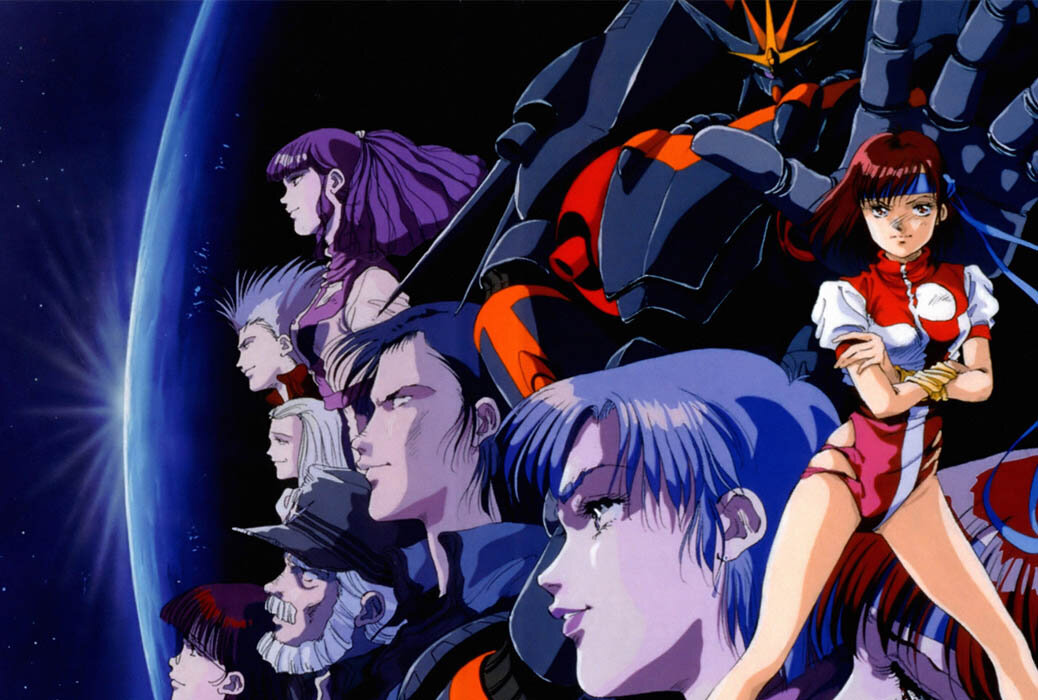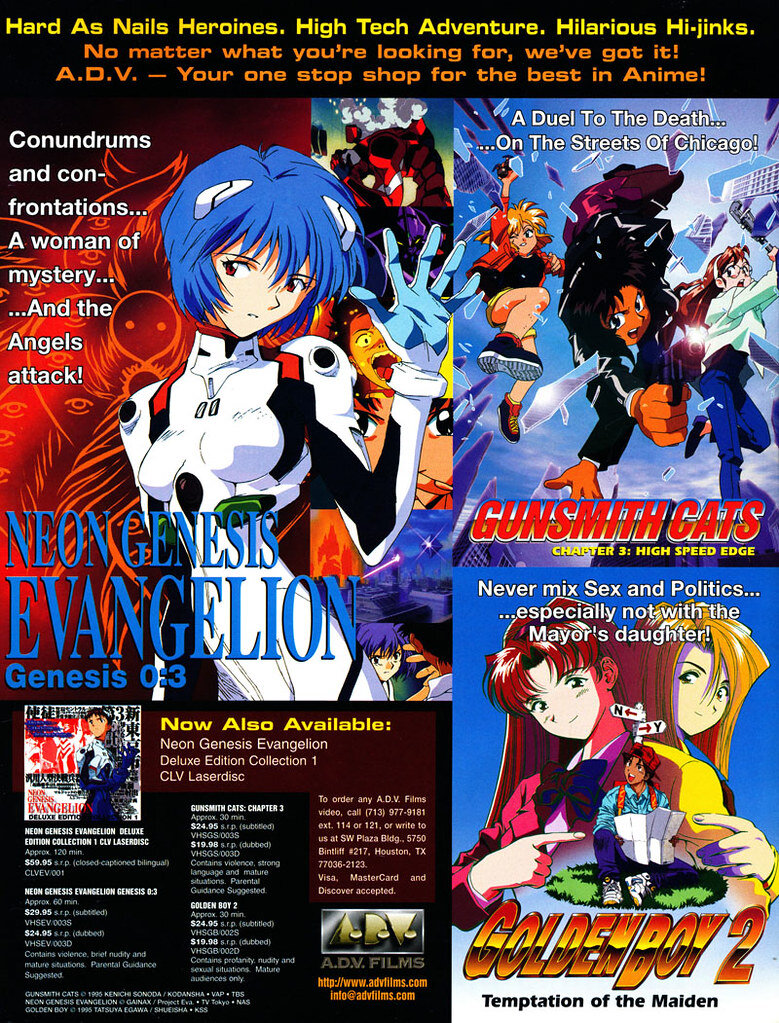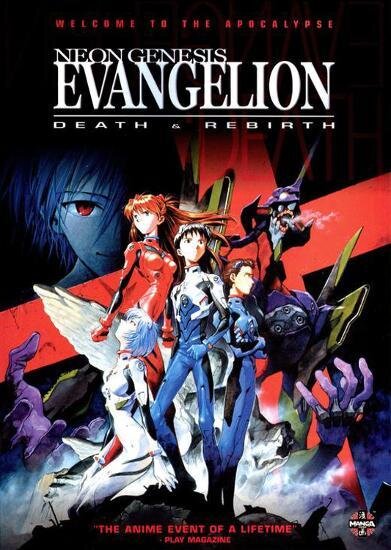Neon Genesis Evangelion // So You Want To Watch Anime
Back in 1996, animation studio Gainax released one of the more influential shows in the anime genre of “Mecha” (aka giant robot punch em ups) since 1979’s Mobile Suit Gundam. While most shows in the genre released since 1979 had become about how war is bad, or stuck to the hyper traditional “really good guys vs super bad guys”, it had become traditional and slightly predictable. Gainax was far from a stranger to the Mecha genre, having already produced the stellar Original Video Animation Gunbuster back in 1988, which built them a reputation for fantastically animated works that make you think and cry.
The director of Gunbuster, Hideaki Anno, had ideas about how to analyze and deconstruct the Mecha genre. Taking inspiration from his own depression, the recent subway Sarin Gas attacks of March 1995, Gundam itself, and a half-dozen other fictional works, Hideaki Anno was able to craft a story that looked at normal humans thrown into an end of the world situation. Gone were the super-heroic children and teenagers. Gone were the morally idealized adults. Gone were the invincible robots and their easy wins. What was left would leave a mark on anime for years, for better or worse.
Neon Genesis Evangelion starts with young Shinji Ikari. Having been abandoned by his father at a young age, his mother apparently dead, Shinji has been living with his estranged aunt and uncle. However, his father has sent for him, asking Shinji to come to the city known as Tokyo-3. The original Tokyo having been lost in the Second Impact cataclysm, and Tokyo-2 is the capital of Japan.
Did I mention this was technically a post-apocalyptic show? Because it is. This is 15 years after the Second Impact ripped Antarctica asunder and caused oceans to rise with cataclysmic effects back in the year 2000. The death toll from this and the following armed conflicts cut mankind’s population in half.
The day Shinji arrives at the city, he finds it abandoned. Except for the giant monster rampaging up and down Main Street, leaving cross-shaped explosions in its wake. Rescued at the last minute by the other initial main character Misato Katsuragi, Shinji is taken into the underground depths of Tokyo-3, where it turns out that his father now runs a top-secret government agency called NERV that intends to save the world from monsters like the one on the surface. Unfortunately, the only reason that Gendo Ikari has sent for his son Shinji is that he wants him to pilot a massive mobile weapon, the giant robot Evangelion. Further unfortunately, if Shinji refuses to pilot, a seriously injured girl his age will be forced to pilot in his place. Reluctantly, Shinji accepts, and is thrust into hell.
From there, Shinji reluctantly not only becomes the sole pilot of a giant robot, the latter of which has a real temper when its pilot is in mortal danger, but also gets drawn into a story of political intrigue and emotional torment as damaged humans try to connect with one another in the face of total Armageddon.
Also, a lot of time spent on public transportation, too.
The real interesting thing is that Hideaki Anno was able to take a bombastic giant robot anime series with all the traditional tropes, and instead tries to shove it all into a quiet and introspective story. Shinji spends almost as much time staring up at the ceiling in his bedroom as he does piloting a giant robot, or attending local school. While it can muck with the pacing, it also adds psychological analysis to the story when the enemies start getting really eccentric. One of the enemies, called Angels, absorbs the Evangelion and Shinji whole through its shadow. The vast majority of the episode is Shinji exploring the human condition, and wondering how life got this way… before his Evangelion rips its way out from the Angel in the bloodiest way imaginable.
As head writer as well as director, Anno delights in tormenting his audience in many ways. Another major character, the half-German Asuka Langley Sohryu, has similar issues to Shinji with her personality becoming outgoing and borderline egotistical to cover up her trauma. The show hints at the two of them potentially becoming romantically involved, but Anno delights in the audience squirming just as much as the two characters as any possible romance continues to go unanswered.
Despite being remarkably popular when it first came out, Evangelion actually blew through their budget 24 episodes into their 26 episode run. The show still finished… but the episodes became remarkably experimental. Black and white sketches filled the screen, with Shinji speaking to someone with a familiar voice about the nature of humanity before being congratulated by the cast in one of the most obnoxiously obtuse endings in all fiction.
To quote one of the dub voice actors from his excellent outtake, “ya ran out of ink too, didn’t you? You bastards.”
Anime fans in Japan being the level-headed masters of the written word that they are, the studio Gainax received death threats to no end. Glad to see some things haven’t changed.
A year later, Evangelion would have a pair of movie releases to redo the ending. Death and Rebirth would be a clip show of the TV series and a preview for the next movie: The End of Evangelion. That movie would become even more notorious in anime fandoms around the world, with events chosen seemingly just to piss off the same fans who had written in said death threats. Which were also included in the movie during a particularly weird moment where the characters navel gaze about the nature of humanity. Hideaki Anno truly gave no shits.
I swear to god, this is actually in the movie. It is a scene. A scene where Shinji and… God? talk about the nature of humanity. They later look at the movie theater you are allegedly in.
With the series releases spanning over 30 years, the real question becomes how should one interact with Evangelion. There are now five English translations of varying quality across two major animated works, and a highly recommended manga available in English. How you wish to proceed is up to you.
Ah, the days when an hour of animation cost $30.00, and you only got one language. And god help you if you purchased the Laserdisc version, seeing how they never finished it on Laserdisc.
The first dub was thanks to ADV back in the early days of anime becoming popular, circa 1997. The show had a looser translation than what could be expected these days, but the show felt natural with the dub actors hired. It takes a few episodes for everyone to sound like their characters, but the actors in their roles do fantastic for the era. The original, long out of print, DVDs for the time also include the Japanese audio, and some excellent Spanish and French dubbing for the curious.
Another bonus is that this release genuinely tried to go for an international flavor when it came to characters like Asuka. Her actress for the dub, Tiffany Grant, is fluent in German and was able to help pepper the script with actual slang and words that would help make the character feel German in more than just lip-service. This being an anime dub for the late-90s, it also has some weird issues. One minor character actually had three actors during the show’s run, with one having literally run off to join the circus during the dub.
However, the video quality is miserable, and it was replaced by a ridiculous amount of re-releases. The “ultimate” form of this is the Platinum Collection, which features high quality video for DVD and a touched up script with new dubbing in key places for accuracy. This last form of Evangelion is also insanely hard to find on the secondary market, demanding some high prices.
The two movies came out in 2004, released by Manga Entertainment. Many of the original dub crew were able to reprise their roles, including the major characters while Japan had no such issues. The script is also of a looser translation, but one that keeps the nuance of Anno’s speculation on life while also keeping the characters from sounding like sock puppets. These are also incredibly hard to find, but are worth seeing as an epilogue.
The franchise’s 20th anniversary brought a movie reimagining, called the Rebuild of Evangelion. Hideaki Anno came back to write and direct these movies, and even claimed that he would be making these movies to “fill in the gaps” and answer questions the fans may have had. It was even suggested by Studio Khara (Anno’s post-Gainax animation studio) that these works would be easier for new fans to understand.
Anno and Khara were full of shit.
It is, however, really really pretty.
The three movies released so far are beautiful works of animation, and the first two movies do a great job at updating the franchise for a modern perspective. However, the movies obnoxiously leave a lot of character development on the cutting room floor, making fans fill in the gaps with the 20 year old television show that new fans have certainly not seen by now. New characters are introduced with no explanation beyond fanservice and merchandising, and the story continually hints at the previous End of Evangelion movie that makes it seem like a sequel. While the Rebuild movies are beautiful and feature a fantastically weird story, they are honestly supplemental.
There is also a manga that is a highly respected alternative to the series. Released 6 months before Evangelion premiered, continual delays and interrupted schedules meant the manga wasn’t done until about 2015. Done by Evangelion character designer Yoshiyuki Sadamoto, the book is a condensation of all things Evangelion. Characters receive more depth in spite of a shortened screen-to-page time, with backgrounds that actually help explain their motivations.
The art is spectacular, with characters looking detailed and more emotional than the anime hoped for. Mech fights are smaller but can be more intense, and several of the Angels were axed from the manga for brevity’s sake. Pacing can also be wonky, as the series can take a full volume to adapt what is a single episode in the show, or it could burn up several episodes at once to get past episode content. Luckily, it’s also still in print and triple size volumes can be found at your local bookstore or online easily.
However, the easiest way to watch Evangelion now is actually on Netflix. Announced back in 2016, Evangelion finally made its way through the red tape of licensing, and both thrilled and pissed off fans in the United States for a multitude of reasons. The script was completely re-translated, more closely to match the Japanese original, for better or worse grammatically. It does, however, erase the homoerotic subtextual (but still uttered) romantic feelings that another male Evangelion pilot has for Shinji and replaces it with awkward phrases.
The actors were all new, which irked many who had hoped the eager earlier Evangelion actors could return to reprise their roles once more. The new actors range from good to fantastic, through, so no worries there… but the overly accurate script can hinder their performances in comparison. Further, the ending song of Fly Me To The Moon was replaced with an instrumental song from elsewhere in the series due to “licensing issues.”
Death and Rebirth, as well as End of Evangelion were also similarly treated, with their release hitting Netflix that same day. It’s recommended you watch End of Evangelion after the ending of the TV series, but Death and Rebirth is a skippable experience.
Pirating the old releases, paying insane amounts of money for the legit releases, grabbing the manga, or checking out Netflix, no matter how you look at Evangelion, it is a pretty incredible little show.















